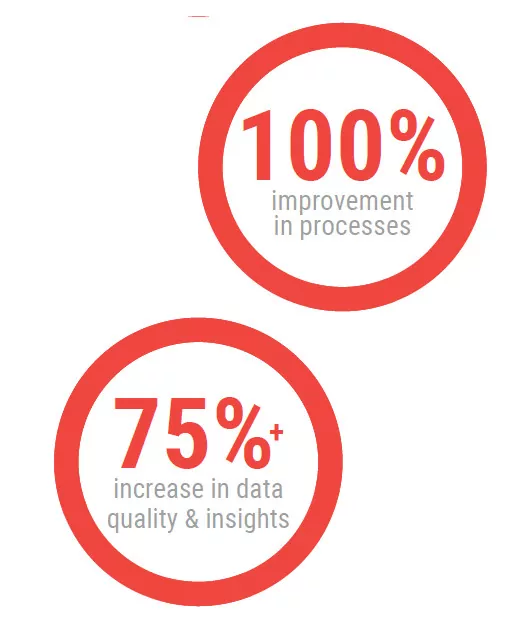CHALLENGE

catalyst for change, the OCIO collaborates closely with bureaus to develop and maintain an efficient,
effective, secure, and well-functioning IT environment.
The office also aims to empower operating units to realize their goals by using IT resources more effectively, minimizing risks associated with IT investments, promoting standardized IT practices and solutions, and safeguarding the department’s information and IT resources against potential threats.
Moreover, the OCIO’s objective is to enhance IT portfolio management, particularly in spending transparency.
DOC has a yearly IT budget of almost $2.6 billion. However, as highlighted in the 2018 President’s Management Agenda (PMA), one of its challenges is the lack of clarity on IT costs and contracts. This obscurity makes it difficult to assess investments, examine expenses, identify patterns, and conduct a thorough analysis.
Analysis revealed millions of dollars were spent on services and products without a clear understanding of which costs were associated with which services and how they supported the mission.
The lack of transparency was compounded by the department’s use of manual processes and unreliable data. Departmentwide silos and the absence of IT governance oversight further exacerbated the issue.
REI SOLUTION
To tackle these challenges, OCIO needed a comprehensive Technology Business Management (TBM) office that would align with the PMA goals to:
- Treat IT like a business
- Foster innovation and business transformation
- Improve services to customers and stakeholders
- Boost cost transparency
- Strengthen overall accountability
REI Systems, as part of the eSTARS joint venture with ADG Tech, was tapped to help OCIO navigate its TBM journey. As a trusted TBM advisor, the team has extensive experience supporting TBM efforts with organizations such as Fannie Mae, GSA OGP, CIO Council, the Office of Management and Budget (OMB), Department of Homeland Security (DHS) Headquarters, Nuclear Regulatory Commission (NRC), Federal Aviation Administration (FAA), Health and Human Services (HHS) Office of Inspector General (OIG), and the U.S. Department of Agriculture (USDA).
Our work with OCIO focused on three areas; Framework, Standards, and DOC TBM PMO:
- Framework: Launch a strategic TBM initiative to evaluate, design, and execute a
comprehensive, standardized, and actionable framework throughout DOC, supporting TBM
aims and objectives. This involves the creation and implementation of TBM processes,
analysis, and reporting within the DOC Office of the Secretary (OSEC). - Standards: Develop a strategy for managing and standardizing TBM reporting across the
entire DOC. - DOC TBM PMO: Launch a dedicated TBM DOC Project Management Office (PMO) within
the OCIO.

We collaborate with key stakeholders to create content-rich TBM artifacts using an agile approach. Our team stays innovative by using virtual tools, recording training sessions, creating easy-to-understand graphics, and preparing for external presentations.
We analyze data from various sources to provide data transparency, re-engineer processes, and create visuals that communicate findings. Our work helps executives make data-driven decisions and address bureau challenges, such as tying TBM requirements to the new financial management system implementation. Our TBM SMEs execute impactful work that showcases OSEC and the DOC TBM PMO.
Our approach was to start small, focusing on a single portfolio and analyzing it thoroughly. However, the manual processes involved made IT transparency in this scenario challenging. Contract support was tracked in Excel spreadsheets, and approvals occurred through email.
As a result, if someone wasn’t included in the approval email chain, they would be unaware of the contract’s status or approval.
The goal was to better understand the operations and processes within the organization, despite the lack of documentation. The initial step was collecting information and documenting the results, which were then shared with the team. We created process flows that visually depicted how various tasks, such as purchasing, transferring money, or budgeting, were executed.
Presenting the information in a clear and accessible format made it simpler to spot gaps or potential issues in the current system. Visualizing the processes shed light on the organization’s operations and identified areas for improvement.
The review of the process uncovered duplications and redundancies. To solve the issues, the team streamlined operations and recommended better ways of doing things based on feedback from team members. The process flows were especially useful in achieving this goal.

We discovered that 80% of the organization’s data was labeled as “other,” leading to a lack of transparency, as a single Budget Object Code (BOC) code was used for most items. That made it difficult to determine the contract type or any additional details.
After recognizing that 80% of its data lacked transparency, the organization understood the significance of obtaining better insights into its spending. The remaining 20% of its data concerned labor costs, which could be identified from a BOC perspective.
However, tracking labor costs in the IT towers area was difficult because of the 80% of data categorized as unknown products and services, leading to a lack of clarity in spending and resource allocation.

To tackle this issue, the team provided coaching and training to improve contract drafting and line item details. This resulted in 100% transparency into the organization’s IT costs, allowing it to better understand its spending and resource allocation.
METHODS
Initially, we improved the existing processes, which took 1.5 to 2 years to implement. The new system facilitated the transition from low-value to high-value work, and we used it to address various data calls. We showcased the auto data management process departmentwide, and several bureaus expressed interest in adopting it.
The team has explored streamlining the Authorization to Operate (ATO) process across the department. This would allow a tool or process authorized at one bureau to be used at another without incurring extra expenses.
To enhance efficiency, the team interacted with stakeholders, conducted interviews, and documented previously undocumented processes. This helped streamline the processes and obtain stakeholders’ support by bringing them to the forefront.
We also focused on improving data quality, streamlining engagement, creating a roadmap, and conducting an environmental scan to understand the tools and technologies used. We connected solutions with problems, identified multiple instances of the same tool, and saved money. Lastly, we helped build out the service catalog to understand the services OCIO had.
ROADMAP
The TBM roadmap was originally designed to support the OS, but it has since expanded to cover the entire department. Currently, there are two distinct roadmaps: one focuses on the OS area, while the other supports the DOC TBM PMO, which includes all the bureaus.
This framework outlines important milestones and prioritizes specific areas of focus, such as automation. It also includes the number of bureaus supported and the cost allocation algorithm for working capital funds. The team held a visioning session with leadership to identify challenges and goals they wanted to address.
Leadership raised concerns about the working capital fund algorithm and challenges with tracking costs and services. The team gathered these challenges and goals, such as understanding network and compute costs or transitioning to the cloud, and developed a plan to address them.
Based on agreed-upon milestones, the team presented these solutions to the client and created a roadmap. They also identified areas for improvement, such as training, and aligned the TBM roadmap with the CIO’s objectives. By doing so, the team demonstrated progress and highlighted its contributions to the CIO’s vision when reporting its accomplishments.

During the TBM initiative, the team gained valuable insights and lessons that could be applied to future similar projects. One of the most significant takeaways was the importance of effective change management strategies and communication. Overcoming initial resistance and breaking down barriers required the team to use various tactics to gain the client’s trust and support.
One such method was demonstrating early improvements to show the value of the team’s work. As the team proved its worth, trust in the team grew, and the team continued to deliver results through its work.
Executive sponsorship was also crucial to the success of the project. The team had the deputy CIO’s support from the beginning, which allowed it to gain buy-in from the rest of the C-suite. This top-down support gave the team the authority to push for changes and improvements.
Lastly, the team found that starting small by conducting pilot studies at the bureau level and implementing successful approaches across the department was an effective strategy. Sharing best practices gained through these studies during PMO sessions or office hours fostered collaboration and continuous improvement throughout the organization.
This approach allowed the team to build momentum and demonstrate value, ultimately leading to adoption and support.
IMPACT
Through the use of change management and other tactics, the team shifted the paradigm in the organization’s technology management approach to one that emphasizes transparency, collaboration, and standardization. OS now has a complete understanding of its IT services and products. There is transparency in which solution supports which mission.
Our wins, time savings, and value demonstration have resulted in bureaus seeking advice on how to move forward with their technology management.
This is a significant change, as historically CIOs are usually asked to purchase desired technologies, not advise. The shift to an advisory role is a noteworthy success story, and other agencies are looking to replicate it.
Moreover, the lessons from this initiative, including the significance of developing trust, securing executive sponsorship, and starting small, can help other agencies drive comparable transformation in their organizations. Our expertise in strategic and tactical TBM, implementation, combined with our hands-on experience in implementing TBM, can serve as a valuable resource for agencies seeking to successfully implement TBM.
BY THE NUMBERS
- Advisory covered 14 bureaus
- TBM implementation was completed across OSEC with 100% success
- Established a service catalog for 4 offices of OS_OCIO
- The implementation of TBM resulted in external labor savings and consolidation of services
- There was a 100% improvement in processes
- Streamlined the data to be leveraged for ~80% of data calls and ~100% for executive reporting
- The team identified $28 million in miscategorized IT
- 50-60% of contracts experienced better budget formulation and allocation of funds
- The review led to a 75-80% increase in data quality and insights





